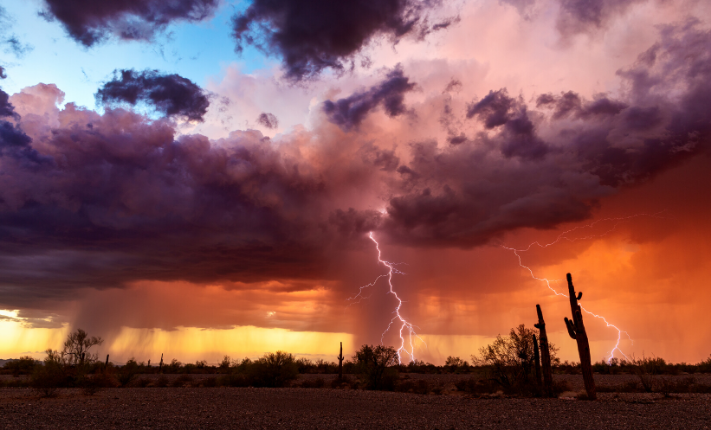
The world is full of strange and unusual weather events that bring many questions to mind. Can showering during a thunderstorm kill you if lightning strikes your home? It probably won’t, but The National Weather Service advises against it. Is it true that lightning doesn’t strike the same place twice? No. Just ask The Empire State Building, which gets struck by lightning an average of 23 times per year. Here are some other weird weather questions, answered:
1. Why does it smell different when it’s raining?
Rain is simply water, so why should it make the world smell different? If you go outside at the beginning of a rainstorm, the unique scent, called petrichor, is caused by the high-speed water hitting the soil and plants. This releases little bursts of chemical compounds into the air.
2. Why are thunderstorms more common in the afternoon and evening?
The afternoon and early evening before the sun begins to go down are the hottest parts of the day. Thunderstorms occur where there are drastic temperature and pressure changes. Therefore, it makes sense for the hot air near the surface, and the cooler incoming air overhead to help fuel severe weather events. Also, more evaporation happens in the warmer hours, and the moisture accumulates in clouds more readily.
3. Can you tell the temperature by counting cricket chirps?
What you might think is an old wives’ tale is fairly accurate. Research has shown that crickets rub their lakes together to make their unique sound at different speeds depending on the outdoor temperature. If you want to figure it out for yourself, add 40 to the number of chirps in 14 seconds to get the Fahrenheit degrees.
4. Why do worms show up after rain?
Earthworms do not come out of the ground during rain to wash off all the mud. They do it so they can breathe. Instead of using lungs, worms take in oxygen through their skin. If they are in the water or very wet mud, they cannot get enough oxygen to survive.
5. What was the coldest temperature recorded on earth?
Antarctica is the coldest place on earth, but you may not realize just how frigid temperatures can get. Using satellite measurements, the lowest temperature ever recorded was -144 degrees Fahrenheit. No one could head out there with a thermometer and get the reading themselves as it would have been instantly fatal.
6. Can wildfires cause tornadoes?
Yes, although they are not weather events. Fire twisters or whirlwinds are fueled by the flames’ heat and are pushed by both natural winds and those caused by the fire itself. They have been recorded up to 400 feet tall and 50 feet wide, which makes them a terrifying sight to see.
7. Do frogs forecast rain?
Although your WeatherFlow forecast is undoubtedly more accurate, frogs can often signal rain. If they start croaking frequently and loudly, it means they are trying to attract a mate. Something in their makeup lets them know when rain is coming to provide ponds and puddles for them to lay eggs in.
8. Can counting the seconds between lightning and thunder really tell you how far away the strike was?
Since sound and light travel at different speeds, you can get a rather accurate indication of how far away a storm is by counting the time between a lightning bolt and thunder rumble. Each mile is equal to approximately five seconds. This flash-to-bang method can help you determine when it’s time to take shelter.
9. Could a nuclear bomb stop a hurricane?
In places hard-hit by hurricanes, people look for any solution, but dropping a nuclear bomb in the middle of a massive weather event doesn’t sound like a good idea. Hurricanes have an enormous amount of energy that would require the equivalent of 10 megaton nuclear warheads every 20 minutes to affect its rotation or structure. The most likely outcome of trying to bomb a hurricane would be a deadly swirl full of not only destructive rain and wind but also radiation.
10. Has it really ever rained frogs and fish?
Yes. There have been historically documented instances when tornadoes have picked up fish, frogs, and other things from waterways and ponds and carried them through the air, dumping them somewhere else after the wind dies down. While this may sound like some magical legend, there are both historical and modern cases of weird “rain” like this.